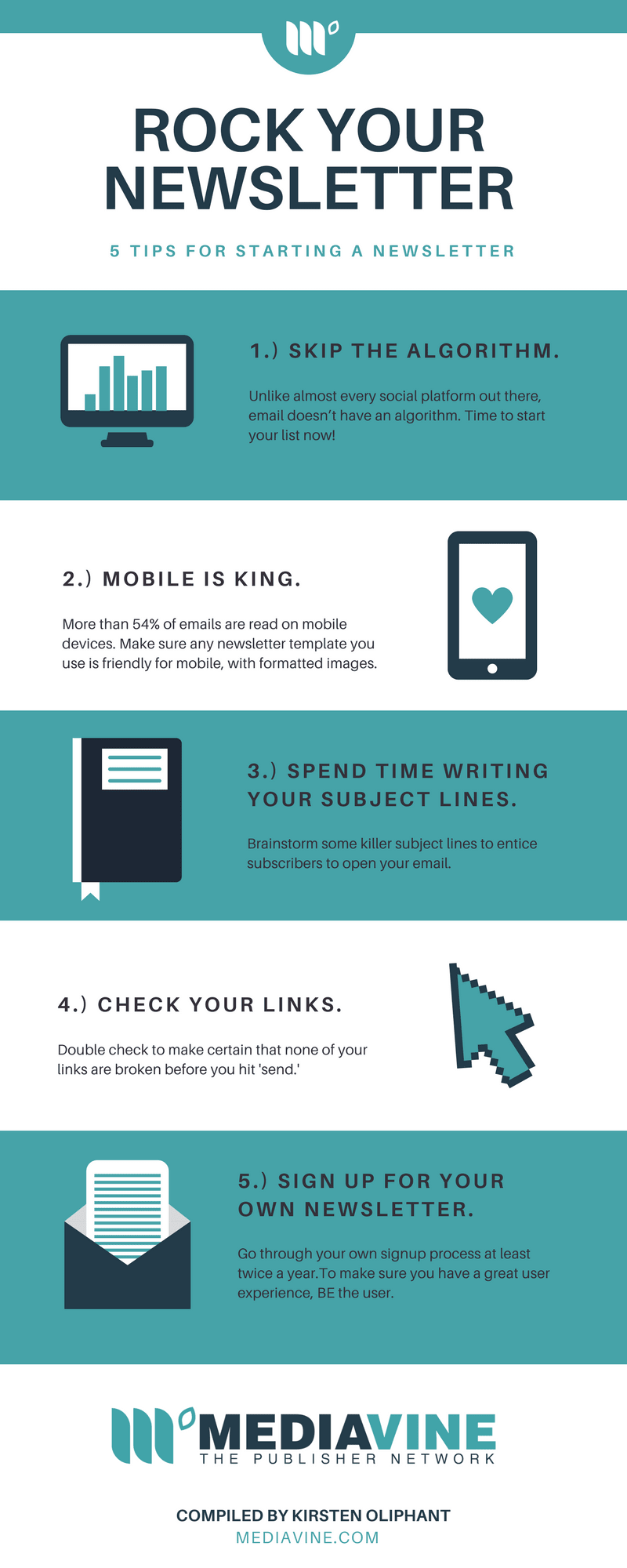Newsletter Lessons You Can Use: 7 Steps to Grow Your Email Marketing Presence


Kirsten Oliphant recently spoke at the Mediavine Publisher Conference with Mary Younkin on how to make the most out of your email lists and newsletter audience. Kirsten is sharing more tips with you here, along with our video of the full conference presentation.
-Amber
YES. Unlike almost every social platform out there, it doesn’t have an algorithm. You also have a more permanent connection to your email subscribers, because you can literally download their emails.
People also have to do more work to subscribe, which means they are already more likely to connect long-term or on a deeper level than someone who just clicks the Follow button Twitter. Email is where I’ve seen my followers turn from readers into raving fans.
But with the number of social platforms people use daily and our crowded inboxes, you need to stand out! Here are six tips to up your email game and see more engagement.

Stats from 2017 find that 54% of email is read on a mobile device. Yet I receive dozens of emails daily that I can’t read without turning my phone sideways or using my fingers to enlarge the text.
Some email providers (like Convertkit) have a mobile-friendly setup built in. Others may require you enlarging your font to something like 16 or 18pt. Test it out! Not just on your device, but have a few friends test it for you on different devices and email apps. Your text should be large enough to read easily on a mobile device without any kind of adjustment.
Email subject lines are as important (if not MORE important) than blog post headlines. Viral content often begins with a killer headline. Upworthy writes 25 potential headlines for every post. (Read more about that in this slideshare.)
Even if you don’t go so far as 25, take time to craft your subject lines. While people respond to numbers and specificity, curiosity is my favorite tool when it comes to subject lines. I like to create what I call itchy subject lines. When you write an Itchy subject line, people HAVE to scratch by opening your email.
This is actually why click bait headlines work so well. They are super itchy–but also disappointing because the content often doesn’t match the subject line. Strive for clickable, not click bait, where your subject line promises what your content actually delivers.
How often do you get an email where the sender’s name is simply a first name? Daily I get emails from Steve or Liz or Becky. I have no idea if Steve/Liz/Becky are my friends, bloggers whose lists I signed up for, or people who scraped my email address and added me without permission.
Always make sure that every email gives context to who you are, what your site is, and maybe even how they signed up. You can do this by changing how the sender name looks in your settings (ex: Kirsten // Create If Writing) or with a quick line in the email itself. (ex: Hey, it’s Kirsten from Create if Writing bringing you the Quick Fix!)
If people don’t know who you are and can’t find some kind of context, they are likely to stop reading and may even mark you as spam rather than just unsubscribing.
Especially if you are using RSS, you need to make sure that your images aren’t blowing up inboxes. Often images are too huge and will make it so your email text runs off the side on mobile and desktop so people have to scroll left and right. You should be resizing your images on your blog anyway (use Mediavine’s handy Optimizing Images guide), but test this out and see if you need to update settings for email as well.

People get paralysis when there are too many things to do. Give them one clear call to action at the end of every email. I send out a weekly resource guide, so it’s a little harder when there are other links to click in the email. Even so, at the end of every email, I have one call to action that is very clear.
My favorite call to action is to ask people to reply and answer a question. Sometimes it pertains to something on my blog or related to my niche. Sometimes it’s what people are binge-watching on Netflix. This one little CTA has been the start of long-term conversations and relationships with my readers. They reply. I reply. This is where the one-to-many communication becomes a one-to-one chat.
Mary highlighted this in our presentation at the Mediavine Conference. I’ll admit that I often skip this step because I’m ready to just hit send. But since our session, I’ve taken to checking all my links when I get to the preview before sending. (You could also send a test email to yourself and check). Almost every time I’ve found at least one mistake! And I consider myself pretty careful and a great editor. Check your links. Just do it.
If you want to get a feel for the real user experience, you need to be a user! Go through your own signup process at least twice a year. Every time I do, I find something that needs to be updated or catch a broken link. To make sure you have a great user experience, BE the user.
For more tips, you can check out my post on how to write emails people actually want to read!
Among the sea of Snapchat, Medium, Facebook, Instagram, and whatever comes next, email isn’t going anywhere. It’s a powerful tool, so make sure you’re giving your list the time and attention it needs to serve you well!
Kirsten Oliphant is a blogger and a writer with an MFA in Fiction. She hosts the Create If Writing podcast, where she helps writers and bloggers learn to build an authentic online platform without being smarmy.

Stay up to date with the latest from Mediavine
 Eric Hochberger
Eric Hochberger
Google recently announced that any publisher passing the new Page Experience algorithm will be considered for the top story carousels in Google News. This shift comes after years of Google …
Eric recently told you about Google Web Stories — a fun and actionable way to get new readers to your site through Google Discover, a feed reader anyone can use. …
A year that, in many ways, felt like a lifetime is finally coming to a close, and the end of 2020 brings hope for a less “unprecedented” 2021. The past …